How to build a core offer for your business
How did an ex-doctor use his YouTube following to 10x his old salary (from $40k per year to $400k in one cohort)—while building a $5M/year business in 10 hours per week?
We sat down with Ali to find out how he built his core offer—Part-Time YouTuber Academy (PTYA)—to steal his lessons learned, and to give you a step-by-step playbook to build your own business offer.
What’s a core offer? It’s what your target audience is going to get, how they’re going to get it, when they’re going to get it, and how much it costs.
An offer is not just a course, a product, a service, or even a community.
Your core offer is what people are willing to pay for their problems to be solved and packaged in a format that works for them.
In our finding your niche playbook, Codie Sanchez says she would make a community her core offer if she had the option to start her entrepreneurial journey again. Unsurprisingly, Codie’s $10k community and Ali’s $5k intensive accelerator are their highest-ticket offers.
Here are the exact steps Ali and his team used to shift from making $400k per PTYA cohort—to $1.9M per cohort (and the playbook they used to build their next offer around productivity!)
The goal
So, why is creating a single core offer so important?
- Allows you to focus (both your time and your resources). Doing one thing incredibly well can power your business for the long term, while doing 5 half-assed things cannot. 😶
- Establishes trust. Being able to articulate how you uniquely solve people’s problems helps you attract an audience who’s genuinely interested in what you can provide, and helps you become known as a leader in the space.
- Opens the door for collaborations and partnerships. If you do a little bit of everything, it’s hard to find the angle you need to collaborate with other creators or find complementary partnerships.
- Inspires “funnel” thinking. How do you get people to opt-in to your core offer? How do you build trust, help people say yes, and provide value—upfront? What does the customer journey look like?
Ali’s core offer
Ali’s first course and core offer was the Part-Time Youtuber Academy, which he created because of his experience building his Youtube channel (6Med) that taught aspiring medical students how to pass medical school entrance exams.
At the beginning, he monetized his content and grew his audience with in-person training all across the UK—while somehow balancing it all with his last year of medical school.
Is it a surprise for anyone that he then expanded his niche into productivity?
The plan
Although we’re sure that people do in fact care about Ali, he has a point. So how did Ali create PTYA? He assessed the building blocks he was working with:
✅ He had first-hand experience studying and working full-time while creating content on the side.
✅ He deeply understood the pains of people learning YouTube for the first time.
✅ He knew how to monetize his content through his in-person trainings. He had a proof of concept that video creation worked to build an audience that would pay.
✅ He had found success with growing his YouTube channel (100k subscribers within a year and a half of starting) and knew there was demand for the knowledge.
✅ He knew his audience: they were into studying, productivity, business, and content creation.
The result? A course for people in similar situations: stressful careers, without a lot of time, who wanted to get themselves out there on Youtube.
To this day, the first benefit on the landing page is: “Learn from a YouTube creator who successfully balanced a stressful career with channel growth”.
And for at least 5,000 people, that resonated enough to hand over $995.
✍️ Here’s how you can assess if you have the makings of a good core offer:
- Do you have first-hand experience with what you’re creating?
- Do you have an audience? Are you intimately aware of their biggest struggles and pain points?
- Have you done research to make sure your offer solves your target audience’s biggest problems?
- Do you know what form your offer will take? A course, community, etc.
- Do you know how you’re going to offer it? Format, timing, etc.
- Do you know when people are going to be able to consume it? All at once, dripped out over time, etc.
- Do you have an idea of how customers will progress on their journey with you? Where will they start, and go next?
- What are your low, medium, and high-ticket offers? (Hint: You don’t need to have all of this nailed down right away, but your core offer should be in the Goldilocks zone between cheap and expensive.)
The playbook
Post-pandemic, Ali found that revenue for his core offer was declining—and since courses made up 50% of his revenue stream, this was a big deal. So he had to take a big swing.
Ali and his team did some research, and put together a plan to improve their PTYA offer. By testing some new offer creation techniques, as well as funnel and copywriting strategies, his revenue went from $300k per cohort, to a whopping $1.9M per cohort.
Below we’re going to take you through exactly how Ali creates million dollar offers. 👇
Working in sprints
His team creates new offers in 6-week sprints where everyone has a quest that ladders up to overall company objectives.
Step 1: Define what “done” looks like with the 3 F’s
How does he and his team know they’ve succeeded? By clarifying their expectations. Here’s what finishing a full offer looks like for Ali’s team:
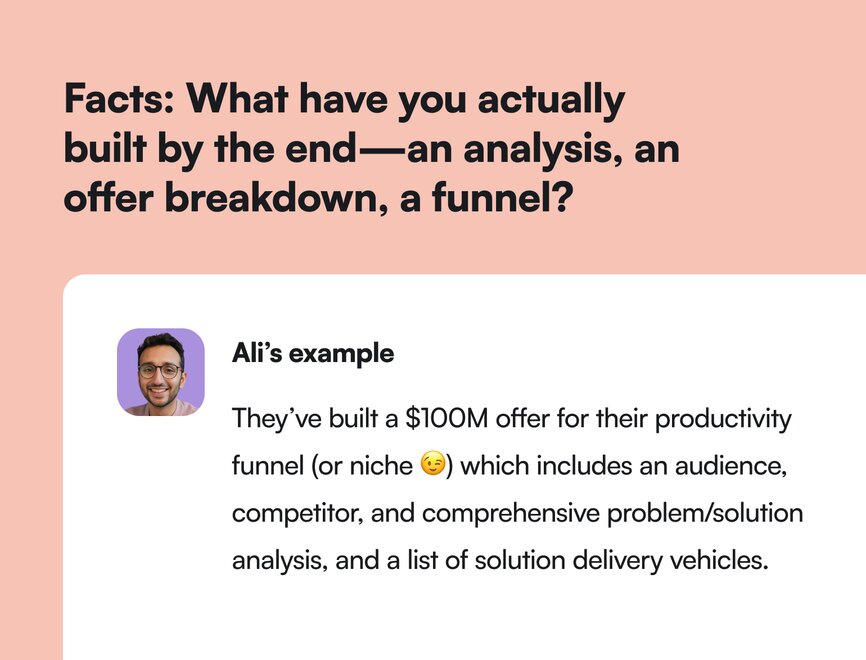
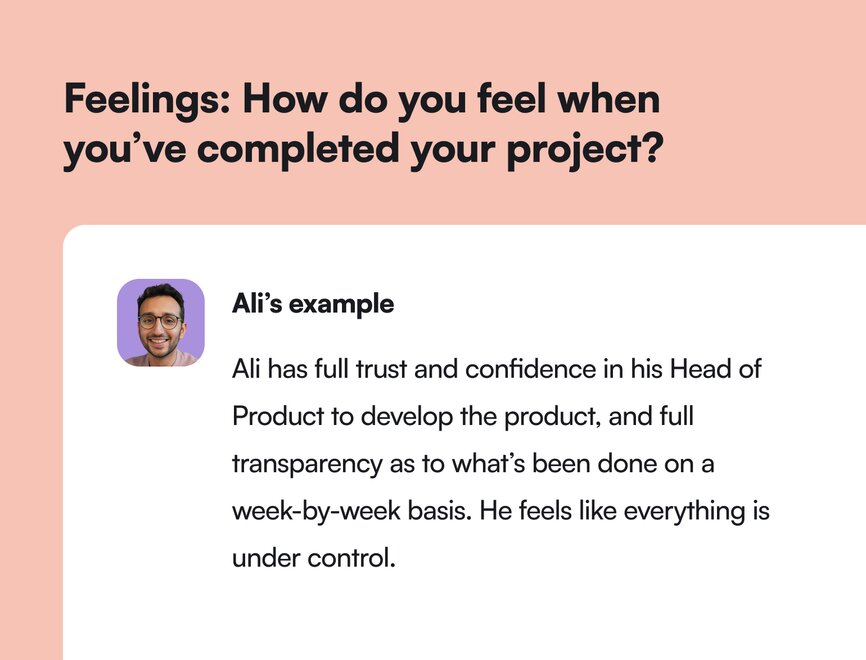
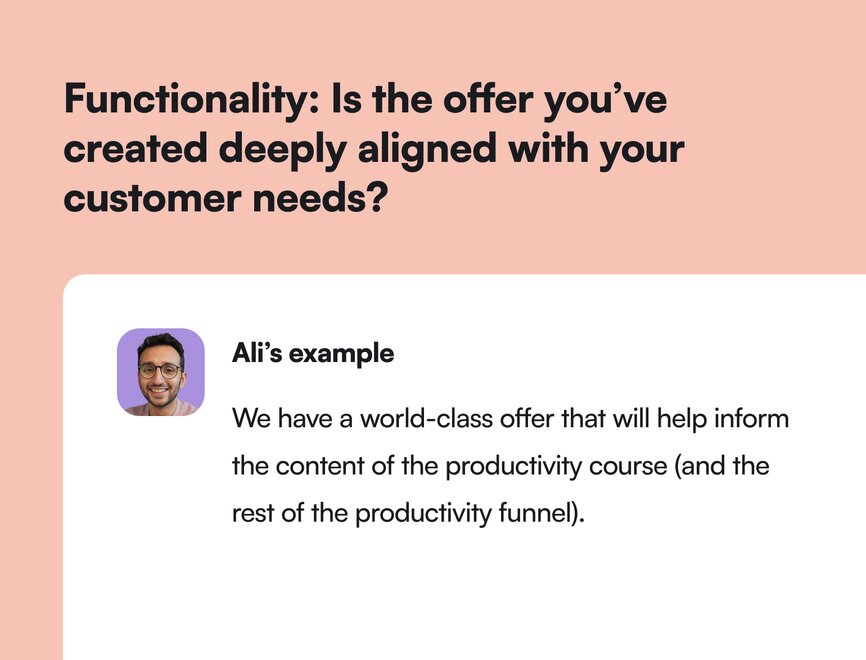
Step 2: Break research up into milestones
After the team is aligned on what it looks like to succeed, they research. A lot.
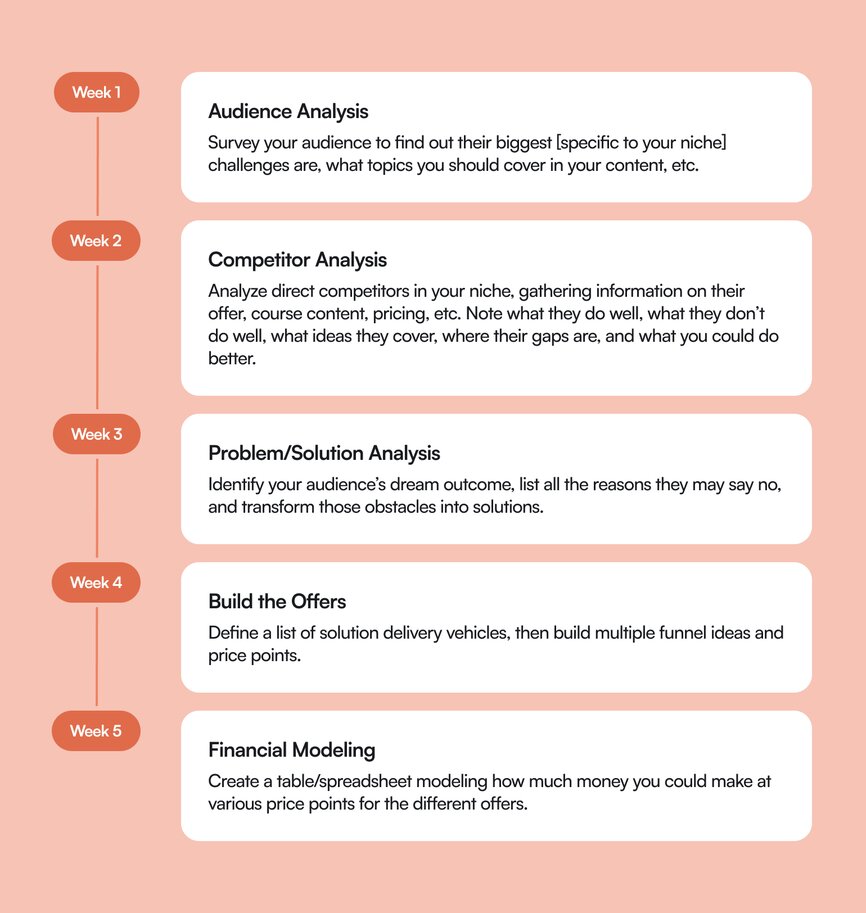
Step 3: Play problem-solution matchmaker
The goal of researching is to create a better understanding of what your audience’s biggest issues are, who you’re competing against, and how your core offer solves them better.
You can do this with surveys as well as one-on-one interviews. Then, you literally turn people’s problems into solutions (and obviously, build those solutions into the offer and marketing).
Try the framework below:
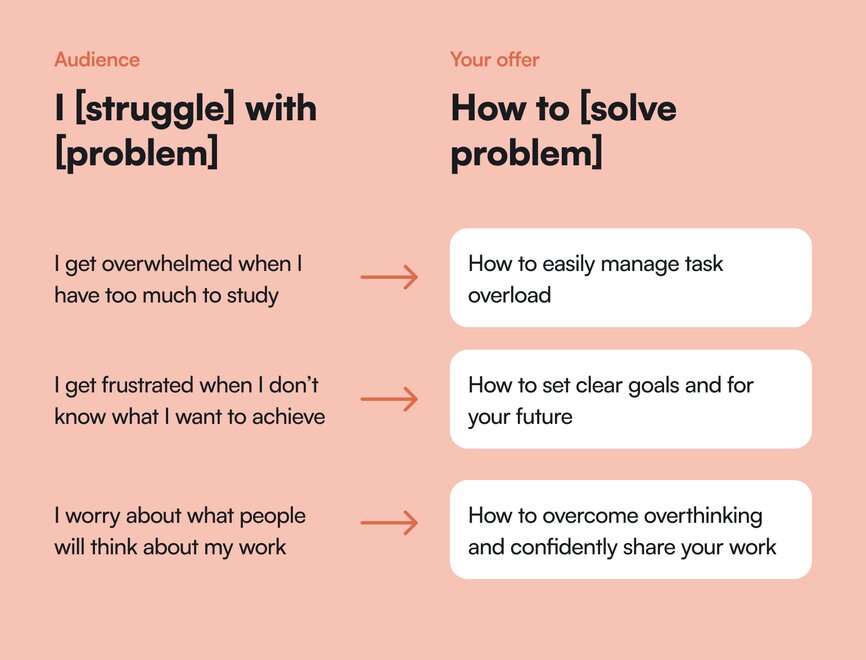
Ali ran through a real example below using “video editors” as the main ICP. Check it out!
How to do core offer research for beginners or teams of one:
“We write 19,000 words purely to understand the problems that our audience is having,” says Ali. “But you can do all the same stuff as a team of one. You don’t need 19,000 words to figure it out.”
First, a gut check: “I’m thinking about making a course about becoming a video editor.”
- Do you have something to teach? Are you a video editor that’s been doing it for years?
- Do you have an audience to sell to? It’s hard to sell a product to zero people.
Second, here are the steps to do audience research on a small scale:
1. Identify the dream outcome for the consumer: Do they want to be a video editor so that they can…
- Make money online working for other YouTubers?
- Get into film production or into TV shows?
- Do freelance work for media companies?
- Get better at editing their own videos as a creator? (Let’s say we pick this one.)
2. Brainstorm the obstacles that people might have when it comes to learning to edit video. You can use your own experience to start, or browse the places your target community hangs out, like blogs, forums, social media, etc. Here’s some sample problems Ali came up with:
- I don't know how to get started.
- Is my computer good enough?
- What gear do I need?
- Why does it take so long?
- Why does my video look janky?
3. Conduct in-depth audience interviews with at least 5 people. “In your next video, email, or tweet, say, ‘Hey, when it comes to editing videos, what's your biggest struggle?’ Then DM those who replied and ask them to hop on a call for 20 minutes to help understand their problems,” says Ali. Ask them loads of questions about what they struggle with, record the call, and thank them for their time.
4. Build a list of problems and solutions from the calls. Look for negative and tense words like “I can’t” “I never”—or just upload the transcript to ChatGPT and ask it to find some problems for a quick-start.
5. Make sure the offer you’re creating includes the most important things in your new problem/solution list.
6. Build your offer!
- What are you creating? A course, community, product?
- How are they getting it? Will it be 1-to-1, small group, or 1-to-many? Is it more do-it-yourself or done-for-you? What kind of support will you provide?
- When are they getting it? Will it be live or pre-recorded? Dripped or at their own pace?
- How much is it going to cost? How much can people afford?
The results
These days, Ali is a New York Times bestselling author on productivity with a 7-figure online business (that he plans to turn into 8-figures soon.) He also recently launched a community called Productivity Lab, hosted on Circle.
But at the beginning, he created PTYA for the audience he built with his free content.
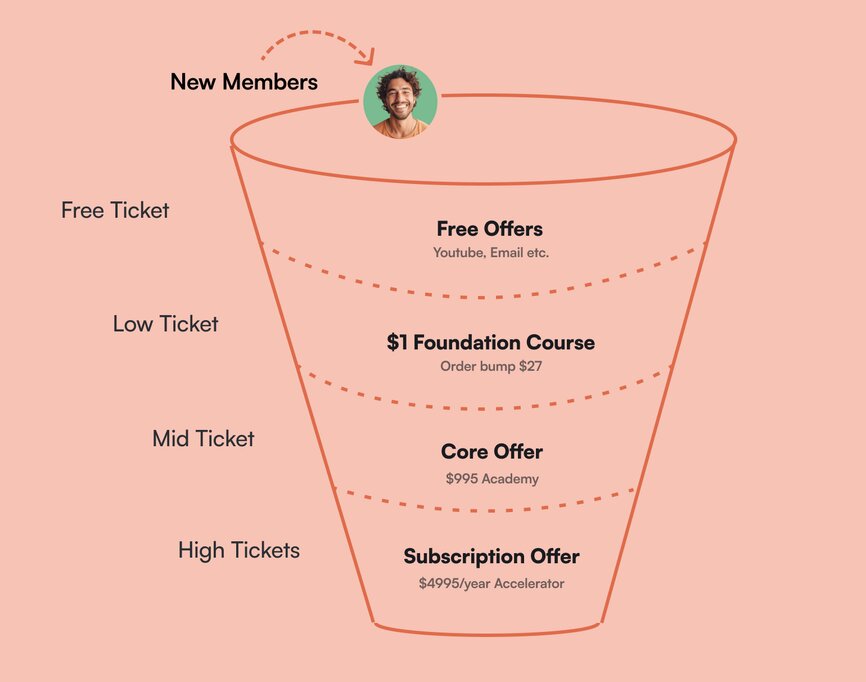
- Gifts = free content: This tier allows you to get first-person access to prospects via their attention or subscription. Ali’s free content includes his YouTube channel, a free 7-day email series, and a scorecard quiz.
- Low ticket offer: Ideally, this isn’t your core offer, but this is something that “opens the door” to investing in you and your knowledge. In all of his free content, Ali pitches his Foundations course for complete YouTube beginners—for $1.
- Core offer: What you’re known for, and what solves your customer’s problems the best. This is the Part-Time YouTube Academy for $995.
- High ticket offer: White-glove, personalized service. Exclusive communities. Masterminds. For Ali, this used to be his $4,995 Part-Time YouTuber Accelerator program. Now, it's his Productivity Lab community!
So not only do you want to offer ways for your audience to “ease in” and test the value they’re getting from you, but you want to offer ways for them to grow with you, offer personalized support, and provide more value as they scale with you.
For more on how Ali structures his offer funnel, watch the video below!
Ali’s learnings:
- Think about monetization early as a creator “because views don’t pay the bills,” says Ali. The old model of being an online creator in the educational space and relying on only AdSense and brand partnerships is stressful. Getting views is hard no matter how many subscribers you have, so you need to drive people into your funnels and opt-in to you.
- Community = massive value. “At first, I thought, what's the point of community? We're here to teach people how to be YouTubers,” said Ali. But, audience surveys showed that 90% of the problems people struggled with were emotional rather than tactical or technical—like motivation, consistency, discipline, or imposter syndrome.
So how do you solve emotional problems for people when you’re creating a course? A community of people who are having the same problems, paired with a supportive community facilitator. “And now we're adding community to basically everything that we do,” he admits. - Guide, not guru. Every creator goes through imposter syndrome—just like all writers get writer’s block. Get comfortable with this feeling, but don’t let it paralyze you from taking action. Think of yourself as a guide who’s sharing what they’re learning on their journey—rather than a guru who has it all figured out.
Key takeaways
- Provide massive value upfront to grow your audience. Who are you going to sell to if you don’t put yourself out there? “The whole method here is lead with value. Give people something tangible. At the end, make an offer for the next tier: like, by the way, would you like to buy a course?” says Ali.
- Talk to your audience. Without knowing their problems intimately, you won’t be able to offer them the right things to solve those burning problems. The only way to do that effectively is to hear it from them.
- Don’t skimp on research. It helps you connect with your audience, build a better offer and product, and grow your business on more than just a hunch.
- Use the problem ➡️ solution framework. Make sure your core offers hone in on how you solve those problems for people. Make a chart, draw the connecting line, and say it loud in your marketing.
And if you’re looking for an all-in-one community platform your audience “can’t say no to”?
You’re in the right place.
Circle brings together your members, discussions, events, courses, and content—all in one place, under your own brand. Plus, you get access to our customer community full of handy resources and over 10,000 community builders on the same journey as you.